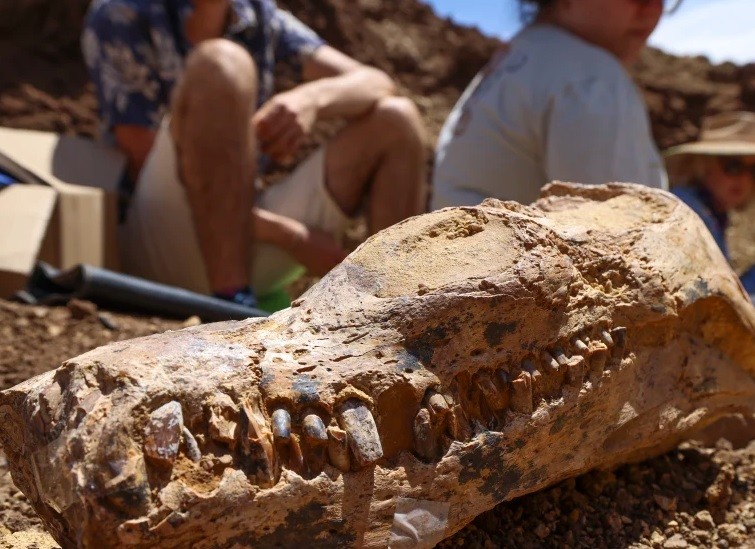One of the most terrifying monsters of the dinosaur age has appeared almost completely with a head and body preserved in ancient rock in Western Queensland – Australia.
According to Sci-News, the specimens were initially discovered by the “Rock Chicks” group of amateur fossil hunters, and then collected and studied by a team of scientists led by paleontologist Espen Knutsen of Queensland Museums Network.
It was identified as a member of the species Eromangasaurus australis, a member of the fearsome group of marine reptiles elasmosaur, a genus of “snake-headed lizards”, known for their long snake-like necks, topped by their heads. monstrous with a long snout and sharp teeth, the body is almost “standard” dinosaur with 4 legs replaced by 4 large and strong fins.

Photograph of fossils among paleontologists, covered with “ghosts” with graphics to make it easier to visualize the super monster when it was alive – Photo: QUEENSLAND MUSEUM
This Eromangasaurus australis lived about 100 million years ago, in the Cretaceous period, sweeping fish and squid in the monster-filled seas of the dinosaur age.
Start “sex” with something that helps her husband stay healthy and happy. Wonderful!samkyvuong.net
Dr Knutsen said it would be the first known head and body of an Eromangasaurus australis to be displayed in the Queensland Museum’s collection.

“We are extremely excited to see this fossil – it is like the Rosetta Stone of marine paleontology because it may hold the key to unraveling the diversity and evolution of the serpent-headed pterosaurs. Cretaceous in Australia,” he added.
The Rosetta Stone is an Ancient Egyptian stela made of granodiorite that bears a decree issued in Memphis in 196 BC by pharaoh Ptolemy V, written in Egyptian hieroglyphics, Ancient Greek and Demotic script. Thanks to that, modern humans had the first basis to translate Egyptian hieroglyphs, which had been lost for many centuries.
The newly unearthed super-monster fossil is also expected to be the same “enlightenment” stele, because of the completeness from the state of the specimen to the state of undisturbed arrangement.

Terrifying portrait of Cretaceous sea monster – Photo: SCITECH DAILY
“Because these snakeheads have two-thirds of their bodies in the neck, which usually separates the head from the body after death, it is difficult to find fossils that preserve the two together,” explained Dr Knutsen. prefer.
Queensland Museums Network chief executive Dr Jim Thompson said: “We currently hold the only head and body of an Eromangasaurus australis in the world and this important find will make a huge contribution. for important research into the Cretaceous of Queensland”.
So fossil remains of ancient ocean life, including marine reptiles such as plesiosaurs and ichthyosaurs, are often found across the state, gradually completing the picture of a “system” “sea monster ecology” is full of mystery and fierceness.
Src: thepressagge.com








